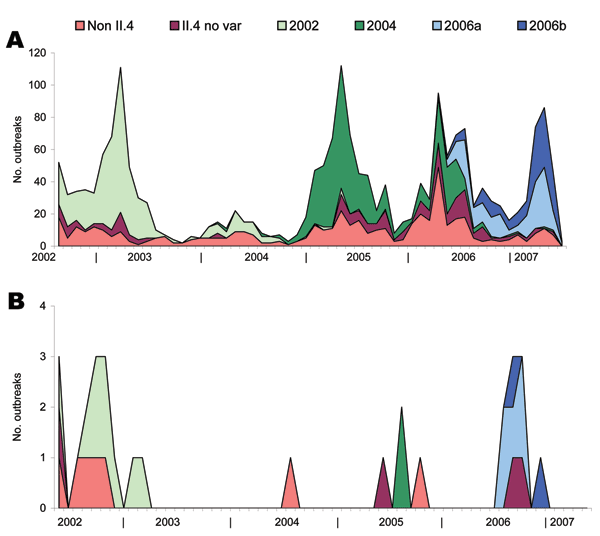Volume 14, Number 2—February 2008
Research
Emergence of New Norovirus Variants on Spring Cruise Ships and Prediction of Winter Epidemics
Figure 2

Figure 2. Cumulative outbreak data over time (2002–2007) from Food Borne Viruses in Europe network database. The total number of reported outbreaks (A) contrasted with the reported ship-related outbreaks (B). Both show norovirus strains involved.
1On behalf of the Food Borne Viruses in Europe Network, the following additional persons contributed significantly to the work described in this article: United Kingdom: Jim Gray, David Brown, Bob Adak, Miren Iturriza (Health Protection Agency); Finland: Carl-Henrik von Bonsdorff (University of Helsinki), Markku Kuusi (National Public Health Institute); Denmark: Blenda Böttiger, Kåre Mølbak, Gerhard Falkenhorst (Statens Serum Institute); Sweden: Kjell-Olof Hedlund, Yvonne Andersson (Swedish Institute for Infectious Disease Control); France: Pierre Pothier, Evelyne Kohli, Katia Balay, Jerome Kaplon, Gael Belliot (University of Dijon); Spain: Albert Bosch, Angela Dominguez (University of Barcelona), Javier Buesa (University of Valencia), Alicia Sanchez Fauquier (Instituto de Salud Carlos III); Hungary: György Szücs, (State Public Health Service), Katalin Krisztalovics (National Center for Epidemiology); Slovenia: Mateja Poljsak-Prijatelj, Darja Barlic-Maganja (University of Ljubljana) Ada Hocevar Grom (Institute of Public Health of the Republic of Slovenia); Italy: Franco Ruggeri, Ilaria Di Bartolo (Instituto Superiore di Sanita); Germany: Marina Höhne, Klaus Stark, Judith Koch, Katharina Alpers (Robert Koch Institute); Ireland: Maureen Lynch (Mater Misericordiae Hospital), Barbara Foley, Paul McKeown (Health Protection Surveillance Centre), Suzie Coughlan (National Virus Reference Laboratory).